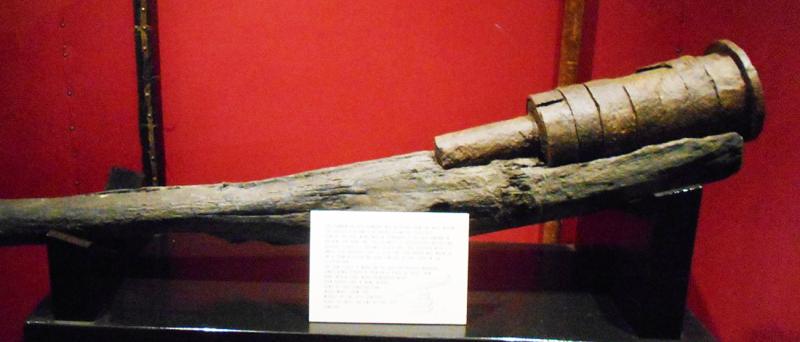A Very Fine, Late Middle Ages, Early Hand-Bombard, Iron Mortar Cannon. The Earliest Form of Ignition Battle Weapon That Developed into The Hand Pistole & Blunderbuss
Used in both the field of combat or from a castle battlement. This fine piece would make a wonderful display piece, perhaps set on a small plinth. Ideal for a desk, bookshelf or mantle.
The weapon that provided the name to the Royal Artillery rank of bombardier, and the word 'bombardment'.
A hand bombard was the larger version of the handgonne or hand cannon, yes still a good size for handling.
Small enough and light enough to be manoeuvred by hand and thus then loosely fixed, or semi-permanently fixed, in either an L shaped wooden block and used like a mortar, or, onto a length of sturdy wooden haft, from three feet to five foot long to be used almost musket like and bound with wrought iron bands see illustration in the photo gallery of these medievil variations of mounting. The precursor to the modern day pistol and musket from which this form of ancient so called handgonne developed into over the centuries. It is thought that gunpowder was invented in China and found its way to Europe in the 13th Century. In the mid to late 13th Century gunpowder began to be used in cannons and handguns, and by the mid 14th Century they were in relatively common use for castle sieges. By the end of the 14th Century both gunpowder, guns and cannon had greatly evolved and were an essential part of fortifications which were being modified to change arrow slits for gun loops. Bombards and Hand cannon' date of origin ranges around 1350. Hand bombards and hand cannon were relatively inexpensive to manufacture, but the skill required to make them was considerable, but they were not that accurate to fire. Nevertheless, they were employed for their shock value. In 1492 Columbus carried one on his discovery exploration to the Americas.
Conquistadors Hernando Cortez and Francisco Pizzaro also used them, in 1519 and 1533, during their respective conquests and colonization of Mexico and Peru. Not primary arms of war, hand bombards and hand cannon were adequate tools of protection for fighting men.
See Funcken, L. & Funcken F., Le costume, l'armure et les armes au temps de la chevalerie, de huitieme au quinzieme siecle, Tournai,1977, pp.66-69, for reconstruction of how such hand cannons were used.
At the beginning of the 14th century, among the infantry troops of the Western Middle Ages, developed the use of manual cannons (such as the Italian schioppetti, spingarde, and the German Fusstbusse).
Photo of the hand bombard recovered from the well at Cardiff Castle, by Simon Burchell - Own work
External width at the muzzle 3.25 inches, length 8 inches. Weight 10.2 pounds
Code: 25213
2695.00 GBP







